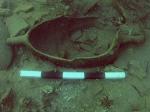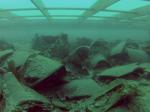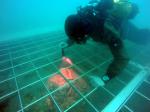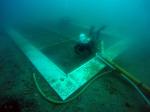Summary (English)
Identified in 1999, thanks to a fisherman, the wreck lies at a depth of 19 m, at about 7 miles from the coast, not far from the site of the Grado 1 wreck. Under the impetus of the Superintendency, a first campaign of exploration took place in the months immediately after the discovery. In fact, a team from Catania University examined the site in order to verify the nature of the find. Several amphora fragments (not in situ) were recovered with the aim of studying the type of cargo. The latter seem to belong to transport containers belonging to the so-called early Greco-Italico group, in particular the MGS VI type as classified by Van Der Mersch, which suggests the amphora from the Grado 2 wreck date to the mid 3rd century B.C. Therefore, the cargo dates the wreck of this ship to a period pre-dating the foundation of Roman Aquileia (181 B.C.).
In more recent years, the Superintendency for Friuli Venezia Giulia began a project for the enhancement of the site in collaboration with Udine University. The need to intervene to protect the site emerged following an inspection made in 2010, when damage was recorded (fig. 1). Between 2012 and 2015, under the direction of Superintendent Luigi Fozzati, two campaigns were carried out aimed at putting into place a metal structure purposely designed to protect and enhance the site.
Thus, the challenge was to comply with both requirements, which appear in contrast for an underwater archaeological site. However, before proceeding with the planning phase, for a wreck on which only one intervention had taken place twelve years before, there was obvious need for more in depth and up to date knowledge of the site. Therefore, the 2012 campaign was divided into two main phases: the first aimed at acquiring documentation relating to the status quo, to determine the extension of the cargo through a visual survey and with a metal probe, lastly the excavation of a shallow trench to identify the most suitable area for the musealisation of the seabed to show a part of the first layer of the cargo. The second phase foresaw the actual planning, construction and positioning on site of the metal structure itself (fig. 2).
The idea behind the design was to create a modular supporting structure on which to position moveable grills. This system would thus make it possible to “open and close” each individual quadrant (2 × 2 m), simply by removing a single protective grill, according to necessity, such as for example maintenance/cleaning of the displayed cargo or further excavation, without however nullifying its value as protection or as enhancement (fig. 3). The fixing screws are prototypes that can only be undone using a specific Allen key. In other words, this system constitutes a sort of purpose-built lock.
In addition to extending the display area, the 2015 campaign also saw the positioning of a protective cornice around the structure. Already during the 2012 campaign, it was seen that by digging manually at the sides of the metal structure, or simply by taking advantage of the natural yielding of the excavation walls, it could be possible to reach the exposed cargo. At the conclusion of the work on the Grado 2 wreck, 32 m2 resulted as potentially visitable by divers through eight grills from which to observe part of the cargo (fig. 4). The structure also has two explanation panels attached to it.
- Massimo Capulli (Dipartimento di Studi umanistici e del patrimonio culturale – Università degli Studi di Udine
Director
- Edoardo Tortorici-Dipartimento di Scienze Umanistiche – Università degli Studi di Catania
- Massimo Capulli-Dipartimento di Studi umanistici e del patrimonio culturale – Università degli Studi di Udine
Team
- Alessandro Pellegrini-Andreia Studio Associato
Research Body
- Dipartimento di Scienze Umanistiche – Università degli Studi di Catania
- Dipartimento di Studi umanistici e del patrimonio culturale – Università degli Studi di Udine
Funding Body
- Soprintendenza per i Beni Archeologici del Friuli Venezia Giulia






![Download [PDF]](/excavation/skins/fasti/images/results/download_sml.png)


